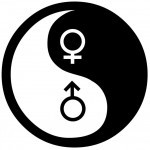The Four Laws of Dynamic Equilibrium
Tuesday, 30 June 2015
Introduction
Yin Yang Theory, illustrated by the familiar Taiji symbol below, seeks to explain the duality, polarity, and dynamic harmony of the physical, mental, and spiritual forces within the universe. These forces affect everything in the universe, manifest and latent, including the expression of the energies between men and women. Fundamental to Yin Yang Theory, and by extension the relationship between men and women, are The 4 Laws of Dynamic Equilibrium, which illustrate how the energies of yin and yang interact with one another. The characteristics of the Yin energy include: female, moon, passive, negative, darkness, earth, water, softness, moisture, night-time, downward seeking, slowness, cold. The characteristics of Yang energy include: male, sun, active, positive, brightness, heaven, fire, hardness, dryness, day-time, upward seeking, restless, hot.
The First Law – Opposition
Yin and Yang stand and manifest themselves as the antithesis of the other. In communication, Yin seeks consensus, while Yang seeks to establish hierarchy. In movement, Yin falls, while Yang rises. In relationship, Yin seeks to bear witness and is process oriented, while Yang seeks to establish agenda, reach resolution, and achieve finality. Yin finds satisfaction in fulfillment, while Yang finds satisfaction in achievement. Simply, Yin is concerned with means, or the journey, while Yang is focused on ends, or the destination.
The Second Law – Interdependence
Yin cannot exist without Yang, and vice-versa. If they separate, life ceases to exist. Yin is the vessel, extended its sails up into the sky, while Yang is the vehicle, pushing the wind that moves the ship across the ocean. Without Yang, Yin stagnates, and without Yin, Yang is ungrounded, lacking purpose or foundation. Yin and Yang are made whole through the interrelationship of their expression, but only in the context of balanced expression. Drive coupled with direction becomes focus. In education, knowledge coupled with pedagogy becomes praxis, or the effective marriage of theory and practice. In parenting, nurturing and discipline create a motivated child with healthy boundaries.
The Third Law – Mutual Consumption
Yin and Yang exist within a dynamically balanced relationship, creating an energetic set point. Whenever Yin is replete, Yang is vacuous. This energetic homeostasis is achieved by the ebb and flow of Yin and Yang. When anger is expressed, the experience of joy is diminished. When victory is pursued, compromise is more difficult to achieve. When energy stagnates, movement ceases. Dogmatism loathes progress and evolution, while blind ambition dislikes limits to its power. When competing as an individual, cooperating as a member of a team becomes impossible. And when love is expressed, hate and resentment have no quarter.
The Fourth Law – Intertransformation
Yin can become Yang in its extreme manifestation, and vice-versa. Each contains the seed of the other. Day becomes night and ice can create fire. Protection can become control and nurturing can become dependency. Extreme passivity can become aggressiveness, just as anger can become remorse. Extreme generosity can lead to resentment and avarice, just as optimism can lead to naivete. And just as physical activity results in rest and sleep, separateness creates a greater appreciation and desire for closeness in relationship. Finally, deep contemplation can result in the elation of a new-found awareness, and developing oneself as an individual can create a stronger and more lasting partnership.
Commentary
The energetic expressions of yin and yang are not dictated by, but are colored by the prenatal essence of each gender, so that male and female have the ability to take on the energetic expression of the other, while retaining their endogenous qualities. All of us contain the energies of both Yin and Yang to varying degrees. Men express Yin energies, just as women express Yang energies. In the context of relationship, the 4 Laws describe how Yin and Yang energies create a road map to a balanced and harmonious relationship, where Yin and Yang energies exist in their proper amounts, and are expressed in appropriate ways. The 4 Laws do not suggest or require that one or the other in a relationship follow a predetermined role. Rather, it observes that the energy of both partners must balance each other in their respective qualities. The 4 Laws also describe the evolution of relationship. Relationship begins with recognition of the disparate energies that attract us to each other, followed by a sense that we cannot be without one another, often called the honeymoon period. Then, as time passes, this feeling shifts into a need for one’s own space, feeling that time spent together is time taken away from one’s personal goals and desires. Until finally, the desire for periods of separateness shifts into a deep appreciation for the effect and influence one’s partner has on one’s identity, forever changing the person you are, which inevitably leads to an attraction to the differences that brought you together in the first place. In a harmonious and nurturing relationship, this cycle continues indefinitely, until Yin and Yang separate, only to be rejoined in the next life.


Great read, great work. Deep journey, there.